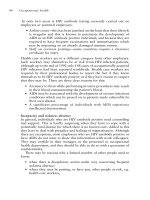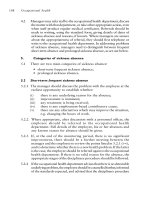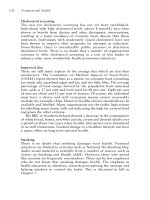Industrial biorenewables a practical viewpoint
Bạn đang xem bản rút gọn của tài liệu. Xem và tải ngay bản đầy đủ của tài liệu tại đây (17 MB, 589 trang )
INDUSTRIAL
BIORENEWABLES
www.ebook3000.com
INDUSTRIAL
BIORENEWABLES
A Practical Viewpoint
Edited by
PABLO DOMÍNGUEZ DE MARÍA
www.ebook3000.com
Copyright © 2016 by John Wiley & Sons, Inc. All rights reserved
Published by John Wiley & Sons, Inc., Hoboken, New Jersey
Published simultaneously in Canada
No part of this publication may be reproduced, stored in a retrieval system, or transmitted in any form or
by any means, electronic, mechanical, photocopying, recording, scanning, or otherwise, except as
permitted under Section 107 or 108 of the 1976 United States Copyright Act, without either the prior
written permission of the Publisher, or authorization through payment of the appropriate per-copy fee to
the Copyright Clearance Center, Inc., 222 Rosewood Drive, Danvers, MA 01923, (978) 750-8400, fax
(978) 750-4470, or on the web at www.copyright.com. Requests to the Publisher for permission should
be addressed to the Permissions Department, John Wiley & Sons, Inc., 111 River Street, Hoboken, NJ
07030, (201) 748-6011, fax (201) 748-6008, or online at />Limit of Liability/Disclaimer of Warranty: While the publisher and author have used their best efforts in
preparing this book, they make no representations or warranties with respect to the accuracy or
completeness of the contents of this book and specifically disclaim any implied warranties of
merchantability or fitness for a particular purpose. No warranty may be created or extended by sales
representatives or written sales materials. The advice and strategies contained herein may not be suitable
for your situation. You should consult with a professional where appropriate. Neither the publisher nor
author shall be liable for any loss of profit or any other commercial damages, including but not limited to
special, incidental, consequential, or other damages.
For general information on our other products and services or for technical support, please contact our
Customer Care Department within the United States at (800) 762-2974, outside the United States at
(317) 572-3993 or fax (317) 572-4002.
Wiley also publishes its books in a variety of electronic formats. Some content that appears in print may
not be available in electronic formats. For more information about Wiley products, visit our web site at
www.wiley.com.
Library of Congress Cataloging-in-Publication Data applied for:
Hardback: 9781118843727
Typeset in 10/12pt TimesLTStd by SPi Global, Chennai, India
Printed in the United States of America
10 9 8 7 6 5 4 3 2 1
www.ebook3000.com
CONTENTS
List of Contributors
xiii
Preface
ix
1 AkzoNobel: Biobased Raw Materials
1
Alistair Reid, Martijn van Loon, Sara Tollin, and Peter Nieuwenhuizen
1.1
1.2
1.3
1.4
1.5
1.6
1.7
1.8
1.9
AkzoNobel’s Biobased Raw Materials Strategy in Context, 1
AkzoNobel in the Value Chain, 3
Drivers Behind Development of the Biobased Raw Material
Strategy, 4
Conclusions of the Biobased Chemicals Strategy, 10
Implementing the Strategy: Striking Partnerships, 13
Experience to Date, 14
Measuring, Reporting, and Ensuring Sustainable Sourcing
of Biomass, 17
Book and Claim, 18
Sustainability in the Value Chain: LCA, 19
2 Arizona Chemical: Refining and Upgrading of Bio-Based
and Renewable Feedstocks
21
Godfried J. H. Buisman and Jos H. M. Lange
2.1
2.2
2.3
Company Introduction, 22
History of Pine Chemicals, 22
Modern Biorefining, 28
v
www.ebook3000.com
vi
CONTENTS
2.4
2.5
2.6
2.7
The Kraft Pulping Process, 34
Cradle-To-Gate, 44
Outlook, 46
Case Study: Tackifiers From Renewable Pine-Based Crude Tall Oil
and Crude Sulfate Turpentine for Adhesive Applications, 49
Acknowledgments, 57
References, 57
3 Arkema: Castor Reactive Seed Crushing Process to Promote
Castor Cultivation
63
Jean-Luc Dubois
3.1
3.2
3.3
3.4
3.5
3.6
Arkema: Context for Biorenewables, 64
Introduction to Castor Oil, 65
Experimental Details, 72
Results, 77
Discussion, 85
Conclusion, 92
Acknowledgments, 93
References, 94
4 Avantium Chemicals: The High Potential for the levulinic product
tree
97
Jan C. van der Waal and Ed de Jong
4.1
4.2
4.3
4.4
Introduction, 97
Levulinic Production Routes, 101
The Levulinic Acid Product Family Tree, 107
Conclusions and Outlook, 116
References, 117
5 C5LT: Biorenewables at C5 Ligno Technologies AB
121
Kaisa Karhumaa and Violeta Sànchez i Nogué
5.1
5.2
5.3
5.4
5.5
Introduction, 121
Lignocellulosic Ethanol Production: Process, 123
C5LT Gene Package Technology, 129
Fermentation of Lignocellulosic Hydrolysates: Remaining
Challenges, 136
Conclusions, 137
Acknowledgments, 138
References, 138
6 Cepsa: Towards The Integration of Vegetable Oils and Lignocellulosic
Biomass into Conventional Petroleum Refinery Processing Units
141
Maria Fé Elía, Olalla de la Torre, Rafael Larraz, and Juana Frontela
www.ebook3000.com
vii
CONTENTS
6.1
6.2
6.3
6.4
About Cepsa, 142
Vegetable Oils, 149
Lignocellulosic Biomass, 167
Concluding Remarks, 172
References, 173
7 DuPont: Biorenewables at E.I. DU Pont DE Nemours & Co
175
Michael A. Saltzberg, Armando M. Byrne, Ethel N. Jackson,
Edward S. Miller Jr., Mark J. Nelson, Bjorn D. Tyreus, and Quinn Zhu
7.1
7.2
7.3
7.4
7.5
7.6
7.7
DuPont History and Strategic Priorities, 176
DuPont’s Innovation Philosophy, 178
DuPont’s Industrial Biorenewable Portfolio 2013, 180
Case History #1: Bio-PDO and Sorona, 182
Case History #2: Development of Yeast-based Omega-3s
for Verlasso Harmoniously Raised Salmon, 194
Future Directions for Dupont in Industrial Biorenewables, 210
Summary, 213
References, 213
8 Evonik: Bioeconomy and Biobased Products
219
Henrike Gebhardt, Peter Nagler, Stefan Buchholz, Stefan Cornelissen,
Edda Schulze, and Achim Marx
8.1
8.2
8.3
8.4
8.5
Introduction, 220
Biobased and Bioprocessed Products (1), 225
Products Produced from Biobased Feedstock by Conventional
Catalysis (2), 234
Biodegradable Products (3), 239
Enabling Chemicals (4), 239
References, 241
9 Market Structure and Growth Rates of Industrial Biorenewables
245
Gunter Festel
9.1
9.2
9.3
10
Background for Industrial Biorenewables and Data Sources, 245
Market Overview and Growth Rates, 247
Examples for Biotechnology-Based Products Related to
Biorenewables, 252
References, 254
Göteborg Energi: Vehicle Fuel From Organic Waste
Eric Zinn and Henrik Thunman
10.1 The Company, 256
www.ebook3000.com
255
viii
CONTENTS
10.2 Sweden’s Renewable Energy Targets and the Role that Biogas
Will Play in Meeting these, 256
10.3 Biogas in Transportation: Case Studies Within Göteborg Energi, 257
10.4 The Role of Gasification Technology in the Future as the Demand
for Biomass-based Energy and Fuel Grows, 264
11
Greasoline: Biofuels From Non-food Materials and Residues
267
Georg Dahmen, Peter Haug, Gunter Festel, Axel Kraft, Volker Heil,
Andreas Menne, and Christoph Unger
11.1
11.2
11.3
11.4
11.5
12
Fuels and Chemicals: Necessity of Renewables, 268
Evolving Markets for Greasoline® Technology, 269
Technology Overview Greasoline®, 270
Description of Business Model, 271
Diesel from Different Raw Materials, 274
References, 280
Green Applied Solutions: Customized Waste Valorization Solutions
for a Sustainable Future
283
Chunping Xu and Rafael Luque
12.1
12.2
12.3
12.4
13
Introduction, 283
The Company, 285
Projects and Future, 287
Conclusions and Prospects, 292
Acknowledgments, 293
References, 293
Grove Advanced Chemicals: Flox® Coagulants – Environmentally
Friendly Water and Wastewater Treatment Using Biodegradable
Polymers From Renewable Forests
Bárbara van Asch, Paulo Martins, Filipe Santos, Elisabete Sepúlveda,
Pedro Carvalho, Richard Solal, Carlos Abreu, Rui Santos, Jorge Vasconcelos,
Philippe Geyr, and Henrique Villas-Boas
13.1
13.2
13.3
13.4
13.5
13.6
13.7
Introduction, 296
Company Overview, 297
Coagulation and Flocculation in Water Treatment, 298
Flox® Coagulants, 298
Company and Product Certifications, 302
Case Studies, 303
Future Perspectives, 320
References, 321
www.ebook3000.com
295
ix
CONTENTS
14
Heliae Development, LLC: An Industrial Approach
to Mixotrophy in Microalgae
323
Eneko Ganuza and Anna Lee Tonkovich
14.1
14.2
14.3
14.4
15
Preamble, 323
Introduction to Heliae Development LLC, 324
Mixotrophy, 325
Implementation of Industrial Mixotrophy: A Case Study, 332
Acknowledgments, 339
References, 339
InFiQuS: Making the Best of Leftovers
341
Inmaculada Aranaz, Niuris Acosta, María N Mengíbar, Laura Calderón,
Ruth Harris, and Ángeles Heras
15.1
15.2
15.3
15.4
15.5
16
Brief Description of InFiQuS, 342
Valuable by-products Under Research by InFiQuS, 345
Examples of Products Co-developed by InFiQuS, 360
Market Situation, 362
Needs of Research: Synergies Between Industry
and Academia, 364
References, 366
Biorenewables at Mango Materials
371
Allison Pieja, Anne Schauer-Gimenez, Ann Oakenfull,
and Molly Morse
16.1
16.2
16.3
16.4
16.5
17
Motivation: the Problems with Plastics Today, 372
The Bioplastics Industry: An Overview, 373
Mango Materials – a Novel PHA Production Process, 377
Mango Materials, the Story, 386
The Future – new Ideas for Potential Research, 390
Acknowledgments, 391
References, 391
Novamont: Perspectives on Industrial Biorenewables
and Public-Private Needs
Stefano Facco
17.1 State of the Art and Challenges Faced by Biobased Industries, 397
17.2 Wisdom in the Use of Renewable Raw Materials: The Cascading
Use of Biomass, 400
17.3 Case Study: Bioplastics in Italy: Going For Growth Despite
the Crisis, 401
www.ebook3000.com
397
x
CONTENTS
17.4 The EU Policy Framework and Related Policy Gaps: The EU
Strategy on Bioeconomy and the Role of Industrial Policies, 405
References, 407
18
Novozymes: How Novozymes Thinks About Biomass
409
Brandon Emme and Alex Berlin
18.1 The Company, 411
18.2 Case Study: The Transformation of Cellulose to Ethanol, 412
References, 434
19
Organoclick: Applied Eco-Friendly and Metal-Free Catalysis
for Wood and Fiber Modifications
437
Jonas Hafrén and Armando Córdova
19.1 Introduction, 437
19.2 Eco-friendly and Organocatalytic Surface Modification of
Lignocellulose, 440
19.3 Organocatalytic Cross-linking Between Polysaccharides, 443
19.4 OC Modification of Lignocellulose, 444
References, 449
20
Petrobras: The Concept of Integrated Biorefineries Applied
to the Oleochemistry Industry: Rational Utilization of Products
and Residues via Catalytic Routes
451
Eduardo Falabella Sousa-Aguiar, João Monnerat Araujo Ribeiro de Almeida,
Pedro Nothaft Romano, and Yuri Carvalho
20.1
20.2
20.3
20.4
20.5
21
Introduction, 452
Glycerol Fermentation, 454
Hydrotreating, 458
Decarboxylation, 460
Conclusions, 464
References, 464
Phytonix: Cyanobacteria for Biobased Production Using CO2
Bruce Dannenberg, Peter Lindblad, and Gary Anderson
21.1 Background: The Coming CO2 Economy and Circular Economy
Principles, 468
21.2 Technology for Cyanobacteria and Direct Photobiological
Production, 468
21.3 Phytonix: Path Toward Full Commercialization of the
Technology, 475
21.4 n-Butanol: A Valuable Industrial Chemical and Potential
"Drop-in" Gasoline Replacement, 482
References, 489
www.ebook3000.com
467
xi
CONTENTS
22
Phytowelt Green Technologies: Fermentation Processes and Plant
Breeding as Modules for Enhanced Biorefinery Systems
491
Peter Welters, Guido Jach, Katrin Schullehner, Nadia Evremova,
and Renate Luehrs
22.1
22.2
22.3
22.4
22.5
22.6
Introduction, 492
The Next Step: Beyond Energy Production, 492
Material Uses of Renewable Poplar Biomass, 494
Fermentative Production of High-value Compounds, 495
Cooperations with Chemical Industry, 499
Toward Optimized Biorenewables: Time-Lapse and Smart
Breeding, 502
22.7 Next-Generation Poplars/Plants, 505
22.8 Toward Novel Biorefineries: Networking for Success, 505
References, 506
23
Biorenewables at Shell: Biofuels
507
Jean-Paul Lange, Johan Willem Gosselink, Rob Lee, Evert van der Heide,
Colin John Schaverien, and Joseph B. Powell
23.1
23.2
23.3
23.4
23.5
Introduction, 509
Shell and Biofuels, 510
Development of Advanced Biofuels in Shell, 511
Challenges Leading to More Research, 535
Conclusions, 538
References, 539
Index
545
www.ebook3000.com
LIST OF CONTRIBUTORS
Carlos Abreu, Grove Advanced Chemicals SA. Rua Barão S. Januário 33, 5∘ , sala
5.3-5.4, 4470-473 Maia, Portugal. www.grovechemicals.com
Niuris Acosta, Sustainable Physical-Chemical innovation S.L. (InFiQuS). Paseo
Juan XXIII, n∘ 1. Madrid, Spain. www.infiqus.es
João Monnerat Araujo Ribeiro de Almeida, School of Chemistry, Department of
Organic Processes, Centro de Tecnologia, Bloco E, Ilha do Fundão, Federal University of Rio de Janeiro (UFRJ), Rio de Janeiro, Brazil. www.petrobras.com
Gary Anderson, Department of Agricultural and Biosystems Engineering, South
Dakota State University, Box 2120, Brookings, SD 57007, USA. www.phytonix
.com
Inmaculada Aranaz, Sustainable Physical-Chemical innovation S.L. (InFiQuS).
Paseo Juan XXIII, n∘ 1. Madrid, Spain. www.infiqus.es
Alex Berlin, Novozymes, Inc. 1445 Drew Ave. Davis CA 95618, USA. www
.novozymes.com
Stefan Buchholz, Evonik AG. Paul-Baumann-Strasse. 45772 Marl, Germany. www
.evonik.com
Godfried J. H. Buisman, Arizona Chemical B.V. 1225 W Lathrop Avenue Savannah,
GA 31415, USA. www.arizonachemical.com
Armando M. Byrne, E.I. DuPont de Nemours & Co. 200 Powder Mill Road, Wilmington, DE 19803, USA. www.dupont.com
xiii
xiv
LIST OF CONTRIBUTORS
Laura Calderón, Sustainable Physical-Chemical innovation S.L. (InFiQuS). Paseo
Juan XXIII, n∘ 1. Madrid, Spain. www.infiqus.es
Pedro Carvalho, Grove Advanced Chemicals SA. Rua Barão S. Januário 33, 5∘ , sala
5.3-5.4, 4470-473 Maia, Portugal. www.grovechemicals.com
Yuri Carvalho, School of Chemistry, Department of Organic Processes, Federal University of Rio de Janeiro (UFRJ), Centro de Tecnologia, Bloco E, Ilha do Fundão,
Rio de Janeiro, Brazil. www.petrobras.com
Armando Córdova, Department of Natural Sciences, Engineering and Mathematics,
Mid Sweden University, SE-851 70 Sundsvall, Sweden; Berzelii Center EXSELENT on Porous Materials, Arrhenius Laboratory, Stockholm University, SE-106
91 Stockholm, Sweden. www.organoclick.com
Stefan Cornelissen, Evonik AG. Rellinghauser strasse 1-11. 45128, Essen, Germany.
www.evonik.com
Georg Dahmen, Greasoline GmbH. Osterfelder Str. 3. D-46047. Oberhausen.
Germany. www.greasoline.com
Bruce Dannenberg, Phytonix Corporation. One Town Square Blvd., Suite 315.
Asheville, NC 28803, USA. www.phytonix.com
Jean-Luc Dubois, ARKEMA, 420 Rue d’Estienne d’Orves, 92705 Colombes,
France. www.arkema.com
Maria Fé Elía, Cepsa Research Centre, Avenida Punto Com, n∘- 1. 28805. Alcalá de
Henares. Madrid. Spain. www.cepsa.com
Brandon Emme, Novozymes North America, Inc., Franklinton, NC, USA. www
.novozymes.com, Present address: ICM Inc. 2811 S 11th Street Rd, St Joseph,
MO 64503, United States
Nadia Evremova, Phytowelt Green Technologies GmbH. Kölsumer Weg 33.
D-41334 Nettetal, Germany. www.phytowelt.com
Stefano Facco, Novamont SpA. Via Fauser 8. 28100 Novara, Italy. www.novamont
.com
Gunter Festel, Festel Capital, Mettlenstrasse 14. CH-6363, Fueringen, Switzerland.
www.festel-capital.com; Technical University Berlin. Chair of Entrepreneurship
and Innovation Management. Stra𝛽e des 17. Juni 135. D-10623 Berlin. Germany.
www.entrepreneurship.tu-berlin.de; University of Basel. Chair of Financial Management. Peter Merian-Weg 6. CH-4002 Basel. Switzerland. wwz.unibas.ch
Juana Frontela, Cepsa Research Centre, Avenida Punto Com, n∘- 1. 28805. Alcalá
de Henares. Madrid. Spain. www.cepsa.com
Eneko Ganuza, Heliae Development, LLC. 578 E. Germann Road. Gilbert, AZ
85297. USA. www.heliae.com
LIST OF CONTRIBUTORS
xv
Henrike Gebhardt, Evonik AG. Rellinghauser strasse 1-11. 45128, Essen, Germany.
www.evonik.com
Philippe Geyr, Grove Advanced Chemicals SA. Rua Barão S. Januário 33, 5∘ , sala
5.3-5.4, 4470-473 Maia, Portugal. www.grovechemicals.com
Johan Willem Gosselink, Shell Technology Centre Amsterdam. Grasweg 31, 1031
HW. Amsterdam, the Netherlands. www.shell.com
Jonas Hafrén, Department of Forest Products, Swedish University of Agricultural
Sciences, 750 07 Uppsala, Sweden. www.organoclick.com
Ruth Harris, Sustainable Physical-Chemical innovation S.L. (InFiQuS). Paseo Juan
XXIII, n∘ 1. Madrid, Spain. www.infiqus.es
Peter Haug, Greasoline GmbH. Osterfelder Str. 3. D-46047. Oberhausen. Germany.
www.greasoline.com
Evert van der Heide, Shell Technology Centre Amsterdam. Grasweg 31, 1031 HW.
Amsterdam, the Netherlands. www.shell.com
Volker Heil, Fraunhofer UMSICHT. Osterfelder Str. 3. D-46047. Oberhausen.
Germany. />Ángeles Heras, Sustainable Physical-Chemical innovation S.L. (InFiQuS). Paseo
Juan XXIII, n∘ 1. Madrid, Spain. www.infiqus.es
Guido Jach, Phytowelt Green Technologies GmbH. Kölsumer Weg 33. D-41334
Nettetal, Germany. www.phytowelt.com
Ethel N. Jackson, E.I. DuPont de Nemours & Co. 200 Powder Mill Road, Wilmington, DE 19803, USA. www.dupont.com
Ed de Jong, Avantium Chemicals. Zekeringstraat 29. 1014 BV Amsterdam, the
Netherlands. www.avantium.com
Kaisa Karhumaa, C5 Ligno Technologies AB, P.O. box 124, SE-22100 Lund,
Sweden. www.c5lt.se
Axel Kraft, Fraunhofer UMSICHT. Osterfelder Str. 3. D-46047. Oberhausen.
Germany. />Jos H. M. Lange, Arizona Chemical B.V., Transistorstraat 16, 1322 CE Almere, The
Netherlands. www.arizonachemical.com
Jean-Paul Lange, Shell Technology Centre Amsterdam. Grasweg 31, 1031 HW.
Amsterdam, the Netherlands. www.shell.com
Rafael Larraz, Cepsa Research Centre, Avenida Punto Com, n∘- 1. 28805. Alcalá de
Henares. Madrid. Spain. www.cepsa.com
Rob Lee, Shell Technology Center, 3333 Highway 6 South , Houston, TX 77082,
USA. www.Shell.com
xvi
LIST OF CONTRIBUTORS
Peter Lindblad, Department of Chemistry – Angstrom Laboratory, Uppsala University, Box 523. SE-751 20 Uppsala, Sweden. www.phytonix.com
Martijn van Loon, AkzoNobel Center, Christian Neefestraat 2, 1077 WW Amsterdam, the Netherlands
Renate Luehrs, Phytowelt Green Technologies GmbH. Kölsumer Weg 33. D-41334
Nettetal, Germany. www.phytowelt.com
Rafael Luque, Green Applied Solutions S.L.U., Av. Virgen de Fatima 50, E14014,
Cordoba, Spain. www.greenappliedsolutions.com.es
Paulo Martins, Grove Advanced Chemicals SA. Rua Barão S. Januário 33, 5∘ , sala
5.3-5.4, 4470-473 Maia, Portugal. www.grovechemicals.com
Achim Marx, Evonik AG. Rellinghauser strasse 1-11. 45128 Essen, Germany. www.
evonik.com
Andreas Menne, Fraunhofer UMSICHT. Osterfelder Str. 3. D-46047. Oberhausen.
Germany. />Edward S. Miller Jr., E.I. DuPont de Nemours & Co. 200 Powder Mill Road,
Wilmington, DE 19803, USA. www.dupont.com
Molly Morse, Mango Materials. 490 Lake Park Avenue #16098, Oakland, CA 94610,
USA. www.mangomaterials.com
Peter Nagler, Evonik AG. Paul-Baumann-Strasse. 45772 Marl, Germany. www.
evonik.com
Mark J. Nelson, E.I. DuPont de Nemours & Co. 200 Powder Mill Road, Wilmington,
DE 19803, USA. www.dupont.com
Peter Nieuwenhuizen, AkzoNobel Center, Christian Neefestraat 2, 1077 WW Amsterdam, the Netherlands
Ann Oakenfull, Mango Materials. 490 Lake Park Avenue #16098, Oakland, CA
94610, USA. www.mangomaterials.com
Allison Pieja, Mango Materials. 490 Lake Park Avenue #16098, Oakland, CA 94610,
USA. www.mangomaterials.com
Joseph B. Powell, Shell Technology Center, 3333 Highway 6 South , Houston, TX
77082, USA. www.shell.com
Alistair Reid, AkzoNobel Center, Christian Neefestraat 2, 1077 WW Amsterdam,
the Netherlands
Pedro Nothaft Romano, School of Chemistry, Department of Organic Processes,
Centro de Tecnologia, Bloco E, Ilha do Fundão, Federal University of Rio de
Janeiro (UFRJ), Rio de Janeiro, Brazil. www.petrobras.com
LIST OF CONTRIBUTORS
xvii
Michael A. Saltzberg, E.I. DuPont de Nemours & Co. 200 Powder Mill Road, Wilmington, DE 19803, USA. www.dupont.com
Violeta Sànchez i Nogué, C5 Ligno Technologies AB, P.O. box 124, SE-22100 Lund,
Sweden. www.c5lt.se
Filipe Santos, Grove Advanced Chemicals SA. Rua Barão S. Januário 33, 5∘ , sala
5.3-5.4, 4470-473 Maia, Portugal. www.grovechemicals.com
Rui Santos, Grove Advanced Chemicals SA. Rua Barão S. Januário 33, 5∘ , sala
5.3-5.4, 4470-473 Maia, Portugal. www.grovechemicals.com
Anne Schauer-Gimenez, Mango Materials. 490 Lake Park Avenue #16098, Oakland, CA 94610, USA. www.mangomaterials.com
Colin John Schaverien, Shell Technology Centre Amsterdam. Grasweg 31, 1031
HW. Amsterdam, the Netherlands. www.shell.com
Katrin Schullehner, Phytowelt Green Technologies GmbH. Kölsumer Weg 33.
D-41334 Nettetal, Germany. www.phytowelt.com
Edda Schulze, Evonik AG. Rellinghauser strasse 1-11. 45128 Essen, Germany.
www.evonik.com
Elisabete Sepúlveda, Grove Advanced Chemicals SA. Rua Barão S. Januário 33, 5∘ ,
sala 5.3-5.4, 4470-473 Maia, Portugal. www.grovechemicals.com
Richard Solal, Grove Advanced Chemicals SA. Rua Barão S. Januário 33, 5∘ , sala
5.3-5.4, 4470-473 Maia, Portugal. www.grovechemicals.com
Eduardo Falabella Sousa-Aguiar, Petrobras Research Centre (CENPES), Ilha do
Fundão, Q7, Cidade Universitária, CEP 21949-900, Rio de Janeiro, Brazil; Federal
University of Rio de Janeiro (UFRJ), School of Chemistry, Department of Organic
Processes, Centro de Tecnologia, Bloco E, Ilha do Fundão, Rio de Janeiro, Brazil.
www.petrobras.com
Henrik Thunman, Chalmers University of Technology. Hörsalsvägen 7B. Göteborg,
Sweden. www.goteborgenergi.se
Sara Tollin, AkzoNobel Center, Christian Neefestraat 2, 1077 WW Amsterdam, the
Netherlands
Anna Lee Tonkovich, Heliae Development, LLC. 578 E. Germann Road. Gilbert,
AZ 85297. USA. www.heliae.com
Olalla de la Torre, Cepsa Research Centre, Avenida Punto Com, n∘- 1. 28805. Alcalá
de Henares. Madrid. Spain. www.cepsa.com
Bjorn D. Tyreus, E.I. DuPont de Nemours & Co. 200 Powder Mill Road,
Wilmington, DE 19803, USA. www.dupont.com
Christoph Unger, Fraunhofer UMSICHT. Osterfelder Str. 3. D-46047. Oberhausen.
Germany. />
xviii
LIST OF CONTRIBUTORS
Jorge Vasconcelos, Grove Advanced Chemicals SA. Rua Barão S. Januário 33, 5∘ ,
sala 5.3-5.4, 4470-473 Maia, Portugal. www.grovechemicals.com
Henrique Villas-Boas, Grove Advanced Chemicals SA. Rua Barão S. Januário 33,
5∘ , sala 5.3-5.4, 4470-473 Maia, Portugal. www.grovechemicals.com
Jan C. van der Waal, Avantium Chemicals. Zekeringstraat 29. 1014 BV Amsterdam,
the Netherlands. www.avantium.com
Peter Welters, Phytowelt Green Technologies GmbH. Kölsumer Weg 33. D-41334
Nettetal, Germany. www.phytowelt.com
Chunping Xu, School of Food and Biological Engineering, Zhengzhou University
of Light Industry, Dongfeng Road 5, Zhengzhou, Henan, 450002, P.R. China.
www.greenappliedsolutions.com.es
Quinn Zhu, E.I. DuPont de Nemours & Co. 200 Powder Mill Road, Wilmington,
DE 19803, USA. www.dupont.com
Eric Zinn, Göteborg Energi AB. P.O. Box 53, 401 20 Göteborg, Sweden.
www.goteborgenergi.se
Bárbara van Asch, Grove Advanced Chemicals SA. Rua Barão S. Januário 33, 5∘ ,
sala 5.3-5.4, 4470-473 Maia, Portugal. www.grovechemicals.com
Marian Mengibar, Sustainable Physical-Chemical innovation S.L. (InFiQuS).
Paseo Juan XXIII, n∘ 1. Madrid, Spain. www.infiqus.es
PREFACE
The use of biogenic resources for the production of biofuels and chemicals is
presently a tendency worldwide. Different largely available raw materials – lignocellulosic derivatives, agricultural residues, starch, CO2 , or algae, to cite some of
them – are being thoroughly investigated as potential renewable resources to reach
sustainability targets while keeping (and extending) high life quality standards. Reasons for this trend can be found in the need of replacing fossil-based resources – due
to environmental issues, availability, and geopolitical strategies – while tackling
challenges of an increasing (over) population in the planet at the same time.
Being quite a broad and heterogeneous field, research on renewables is currently
performed at academia from different perspectives, with emphasis on (bio) catalysis, process development, and feedstock valorization, among other important topics.
Interestingly, the industry has also taken the lead in research, development, innovation, and process implementation using renewable resources. Actually, the industrial penetration for renewable raw materials is larger than what one could primarily
expect, with a variety of outstanding examples of well-integrated biorefineries at
industrial level already in use since decades. Novel products and processes are being
implemented each year.
There are many excellent and comprehensive books and review articles covering
the key aspects of the use of renewables to deliver biofuels and chemicals. To complement these, the motivation of this book is to give a more practical perspective
to the renewables field. Thus, this book has been envisioned to be directly written by industrialists to firsthand describe their own current and underdevelopment
(technical) processes, as well as their techno-economic goals. Likewise, their critical reflections and challenge identification lead to a real vision on how renewables
must/should be set up on fluctuating markets in unstable global frameworks.
xix
xx
PREFACE
As a result, 23 diverse companies comprising large and medium established ones
and a number of emerging and highly innovative start-ups have contributed with outstanding chapters. Some firms describe their current processes, products, and the
establishment of novel ones. Other firms have focused on reflecting some challenges
frequently encountered for renewable penetration – mostly dealing with tough economics – or on the need of more in-depth cooperations with academia to secure
success in process implementation. All in all, the book depicts a rather heterogeneous
picture – as it is in real world in renewables – in which interdisciplinary research and
economic constraints are always carefully interconnected for successful applications.
As the ultimate goal, this book will provide readers with very valuable information
on how industries think and develop options in renewables. I do hope that this book
will serve as an inspiring basis for students, academic researchers, and other industrialists to get hints on how practical processes are being envisioned, implemented,
and developed, contributing to bridge the gap between academic targets and industrial ones. As it may be anticipated, this is not an academic book on renewables, and
thus the scientific approach of each topic is not comprehensive, albeit the chapters
actually report on quite a broad state of the art of their different fields, emphasizing
the need of a strong academic expertise to pave the way for innovation at a practical
(economic) level.
I would like to thank warmly all contributors of the book, as they have invested
quite an amount of time and high commitment in delivering wonderful and very useful
chapters. Moreover, I would like to thank my colleagues Dr. Fabrizio Sibilla and Dr.
Andreas Buthe for the fruitful and stimulating discussions on the topics of the book,
as well as Mrs. Anita Lekhwani, Mrs. Cecilia Tsai, and the rest of Wiley team for the
patience and support throughout the preparation of this book.
Dr. Habil Pablo Domínguez de María
Founder, CEO, CSO
Sustainable Momentum, SL
www.sustainable-momentum.net
Las Palmas de Gran Canaria, Spain
1
AKZONOBEL: BIOBASED RAW
MATERIALS
Alistair Reid, Martijn van Loon, Sara Tollin, and
Peter Nieuwenhuizen
AKZONOBEL, Amsterdam, The Netherlands
1.1. AKZONOBEL’s Biobased Raw Materials Strategy in Context
1.2. AKZONOBEL in the Value Chain
1.3. Drivers Behind Development of the Biobased Raw Material Strategy
1.3.1. Background
1.3.2. Existing Use of Biobased Raw Materials
1.3.3. Emerging Products from Biobased Raw Materials
1.3.4. Triggers to Developing an AKZONOBEL Biobased Strategy
1.3.5. Developing the Biobased Chemicals Strategy
1.4. Conclusions of the Biobased Chemicals Strategy
1.5. Implementing the Strategy: Striking Partnerships
1.6. Experience to Date
1.7. Measuring, Reporting, and Ensuring Sustainable Sourcing of Biomass
1.8. Book and Claim
1.9. Sustainability in the Value Chain: LCA
1
3
4
4
5
6
6
7
10
13
14
17
18
19
1.1 AKZONOBEL’S BIOBASED RAW MATERIALS STRATEGY
IN CONTEXT
This chapter sets out AKZONOBEL as a company, its position in the value chain,
and sustainability approach and describes how the company has responded to recent
Industrial Biorenewables: A Practical Viewpoint, First Edition. Edited by Pablo Domínguez de María.
© 2016 John Wiley & Sons, Inc. Published 2016 by John Wiley & Sons, Inc.
1
2
AKZONOBEL: BIOBASED RAW MATERIALS
developments in biobased materials. AKZONOBEL has developed and implemented
a white biotechnology strategy to help respond to the sustainability challenges of
its customers and to contribute toward its corporate sustainability goals. Guided by
this strategy the company is now partnering with innovators and leading companies
in the rapidly developing field of industrial biotechnology and biobased raw materials to bring economic competitive developments delivering meaningful sustainability
improvements to our markets.
AKZONOBEL is a committed and recognized leader in chemical industry sustainability and our proactive effort has been recognized through our presence in the
top three of the Materials Industry group of Dow Jones sustainability index (DJSI)
for each of the last 5 years. We have even been Materials Industry group leader for
each of the last three years. The DJSI benchmarks the sustainability performance
of leading companies based on environmental, social, and economic performance,
including forward-looking indicators, and is regarded as the world’s foremost sustainability index. It assesses various criteria, including supply chain management, operational eco-efficiency, product stewardship, human capital development, and occupational health and safety. AKZONOBEL is building on the basis of active health,
safety, and environment (HSE) programs internally and through supplier support visits (SSV) and works with our key suppliers to improve HSE performance though our
value chain. AKZONOBEL also takes a leading position in cross-sectoral initiatives
such as the World Business Council for Sustainable Development and Together for
Sustainability.
We are further building on this base with eco-premium solutions (EPS) and our
Carbon Strategy. As part of our sustainability effort, AKZONOBEL is helping its customers to address their sustainability challenges by offering products that enable them
to reduce their environmental footprint at competitive price points. To add impetus to
this effort, we developed the concept of EPS in 2007 to translate the eco-innovation
challenge into an operational target for our company. This eco-innovation challenge
was defined by the World Business Council for Sustainable Development as the introduction of any new or significantly improved product – which can be either goods or
services – process, organizational change, or marketing solution that reduces the use
of natural resources (including materials, energy, water, and land) and decreases the
release of harmful substances across the whole life cycle.
EPS are measured using a quantitative analysis or a qualitative assessment of performance in seven categories: toxicity, energy efficiency, use of natural resources/raw
materials, emissions and waste, land use, and risks (e.g., accidents) and health and
well-being (added in 2013) against the most commonly available equivalent commercial products or industrial processes (mainstream solutions) from a life cycle (value
chain) perspective. The EPS must be significantly better with respect to at least one
criterion and have no significant adverse effects with respect to any of the other criteria. The assessment is carried out by an experienced cross-functional group, including
experts in R&D, marketing and sales, purchasing, manufacturing, and eco-efficiency.
Since 2008, the EPS assessment has been audited as part of a broader sustainability
audit.
Our 2020 target is to achieve 20% of revenue from products and services that
provide customers and consumers in our downstream value chain with a significant
www.ebook3000.com
AKZONOBEL IN THE VALUE CHAIN
3
sustainability advantage. This is in addition to our target of increasing revenue share
from EPS (with benefits at any stage of the value chain) to 30% by 2015. Both are
challenging goals because the assessments are made against equivalent mainstream
or standard commercial products and as such are an upward moving target, as both
we and our competitors introduce new and more sustainable products into the market.
Addressing concerns about contribution to and the impact of climate change
prompted AKZONOBEL to establish a Carbon Policy in 2009. In this we recognize the need to move beyond controlling emissions from our own operations
toward – throughout our product chain – identifying and addressing both the opportunities for more sustainable sources of materials and the strategic risks arising from
dependence on fossil fuels and fossil-based raw materials. In line with our commitment to develop eco-efficient solutions for customers, the company acknowledges
that managing our carbon footprint through innovative products, technology, and
energy management constitutes both a business opportunity and a social imperative.
Our target is to reduce our cradle-to-grave carbon footprint by 25–30% per ton
of sales between 2012 and 2020. The cradle-to-grave footprint adds the impact
from our customer applications and end of life of our products to the cradle-to-gate
measure we have used since 2009. Since 2007, we publicly disclose our Policy,
Management and Performance on Energy Efficiency and Carbon Footprint by our
annual reporting to the Carbon Disclosure Project (CDP).
To support these sustainability efforts, AKZONOBEL set out a biobased strategy
that identified opportunities in biobased materials where these might be delivered
economically and maximize the environmental impact reduction. This strategy aims
to forge supply chain relationships that connect these innovations and opportunities
to our markets and application areas.
We have meanwhile struck a number of partnerships as a result of this strategy
and are working through our value chains to bring these to market. Developing and
implementing this strategy have required considerable thought on selection of the
target molecules, engagement with current and emerging suppliers in new ways, and
significant attention on how to address sustainable sourcing and integrating these
materials into existing value chains.
1.2
AKZONOBEL IN THE VALUE CHAIN
AKZONOBEL is a leading global paints and coatings company and a major producer
of specialty chemicals that holds leadership positions in many markets. In 2013 the
company employed approximately 50,000 people and reported revenue of €14.6B
with high-growth markets in Latin America and Asia Pacific representing 44% of
this revenue.
The company is divided into three business areas, each of which represents approximately one third of our revenue:
• Performance coatings. Performance coatings are used predominantly for protection, mainly to industrial consumers having hundreds of uses across a wide
4
AKZONOBEL: BIOBASED RAW MATERIALS
range of industries and sectors including automotive, consumer electronics, aviation, shipping and leisure craft, sport equipment, construction, furniture, and
food and beverage.
• Decorative paints. Our decorative paints business is the world’s leading
decorative architectural paints company supplying a full range of interior
and exterior decoration and protection products for both the professional and
the do-it-yourself markets. The product range includes paints, lacquers, and
varnishes as well as products for surface preparation (predeco products). We
also supply building adhesives and floor leveling compounds for tile, floor, and
parquet layers.
• Specialty chemicals. AKZONOBEL is a major supplier of specialty chemicals
with leading positions in selected market segments. Our products are used in
a wide variety of everyday products such as ice cream, soups, disinfectants,
plastics, soaps, detergents, cosmetics, paper, and asphalt.
AKZONOBEL by and large is not vertically integrated back to the primary extraction of resources but occupies a position in the value chain as a formulator and convertor of chemicals. While AKZONOBEL as the corporation is not widely known, many
of our brands are household names, trusted by customers to brighten, protect, and
preserve their homes, buildings, offices, and factories. These brands include Sikkens,
Dulux, Jozo, International Paints, and Interpon, among others.
1.3 DRIVERS BEHIND DEVELOPMENT OF THE BIOBASED RAW
MATERIAL STRATEGY
1.3.1
Background
AKZONOBEL has, for some years, been actively monitoring progress in the field of
industrial biotechnology, white biotechnology, and biobased raw materials and recognized the advances being made in both industry and academia. Considerable progress
has been made in developing fermentation, catalytic, and thermochemical technologies that could convert biomass from a variety of sources into both energy/fuels and
materials useful to the chemical industry. These new developments have opened up
new ways to produce drop-in replacements for existing and interesting novel materials
from biomass.
Notable examples of progress in existing or drop-in materials we have noted
include exploration of several routes to production of acrylic acid (e.g., through thermochemical conversion of glycerol or fermentation of sugars to 3-hydroxypropionic
acid and subsequent dehydration) and a number of other routes and n-butanol (revisiting the acetone/butanol/ethanol (ABE) fermentation applied some 50–100 years
ago applying new knowledge to improve yield, process, and product mix). Examples
in novel materials include such 2,5-furandicarboxylic acid (FDCA) produced
DRIVERS BEHIND DEVELOPMENT OF THE BIOBASED RAW MATERIAL STRATEGY
5
from sugars and proposed as an alternative to terephthalic acid in resins and PET
packaging and polylactic acid proposed as an alternative to packaging and wrapping
material (e.g., polyethylene/polypropylene).
1.3.2
Existing Use of Biobased Raw Materials
In assessing how to address and respond to these and other developments, our first
step was to better understand what use AKZONOBEL already makes of biobased
materials. Doing so it was found that biobased materials represented a considerably
higher proportion of our raw material base than we expected, wherein 9% by value
of spend raw material has a renewable element (Figure 1.1). We believe that this
compares favorably against our estimate of a chemical industry average of ∼3%, of
which most are traditional biobased materials with only 0.3% coming from recent
developments.
This use of biobased materials is in part ascribable to the long history in coatings
and surfactants, using materials such as tallow, natural oils, rosins, natural waxes,
gums, polysaccharides, etc. These still represent the main use within AKZONOBEL
of biobased materials. In addition, while looking at our use of biobased materials, we
found that we had more knowledge and experience represented inside the company
than we expected and through this traditional base and the efforts of our R&D teams
we held a significant but dispersed body of knowledge. Bringing these experts and
knowledge base together was a significant step in allowing us to recognize and build
on the potential.
Biobased chemicals (%)
9
Some
examples:
tallow
soybean oil
cellulose
alkyd resin
3
“new”
biobased
3
0
Industry AKZONOBEL
average
Figure 1.1 Wider chemical industry and AKZONOBEL use of renewable raw materials.
6
AKZONOBEL: BIOBASED RAW MATERIALS
1.3.3
Emerging Products from Biobased Raw Materials
Building on this strong base, AKZONOBEL has also been active in developing and
delivering to our markets a number of new biobased products and materials. These
include examples such as Dissolvine GL chelating agent and our hybrid polymer
technologies for formulation of cleansers and detergents. Dissolvine GL is part of
our range of chelating agents wherein the majority of the molecule originates from
a natural, renewable source. It is a safe and readily biodegradable alternative for
phosphates, NTA, and EDTA and can be used in a number of applications, such
as detergents, personal care and cosmetics, hard surface cleaning, automatic and
mechanical dishwashing, oilfield chemicals, etc. Hybrid polymer technology is used
in cleansers and detergents replacing the typically used synthetic water-soluble polymers. AKZONOBEL has developed a way to modify a natural polysaccharide “backbone” to make hybridized polymers that incorporate over 60% renewable ingredients
and are nontoxic and readily biodegradable yet match or surpass the performance of
the wholly synthetic alternatives.
1.3.4
Triggers to Developing an AKZONOBEL Biobased Strategy
As we monitored the sector, we noted three significant developments that triggered a
more detailed assessment on whether to engage and respond and if so how:
• Supply. The supply of biobased materials is growing rapidly and many useful
materials are becoming cost competitive.
• Demand. There is a growing customer interest and business drive for greener
products.
• Carbon footprint. There is an increasing focus on reduction of greenhouse gas
emissions.
Furthermore, three possible drivers were identified for our company to more
actively address this area:
• Security of supply. Can renewable raw materials create alternative sources of
supply addressing current or future bottlenecks in our value chain?
• Market position. Can renewable raw materials strengthen our position as
world’s leading coatings and specialty chemicals company?
• Sustainability. Can renewable raw materials contribute toward realizing our sustainability targets?
It is worth noting that we did not base our analysis on the assumption of a green
premium or niche market segments. It was, and still is, our clear belief that to be
meaningful and make a genuine difference in sustainability, biobased materials will
have to achieve economics and volume that allow them to compete on level terms
with the incumbent petrochemicals and in mainstream markets.
Biobased raw materials do not sit isolated from the wider chemical market. Petrochemicals are primarily utilized for the production of energy and changes in supply
DRIVERS BEHIND DEVELOPMENT OF THE BIOBASED RAW MATERIAL STRATEGY
7
or demand through resource or technology developments in energy will have a significant knock-on effect on the chemical sector including biobased materials. This
can already be seen with the emergence of shale gas in the United States both as an
energy source and petrochemical feedstock, since this has had the effect of reducing
the prices of C1 and C2 molecules, for example, methanol, acetic acid, and ethylene,
while reduced use of naphtha as a refinery input has created pressures on propylene
and aromatic value chains. This also creates significant intraregion market differences
and is reshaping the political discourse. The full impact of disruptive developments
of shale gas is still to be seen, but one could imagine that further fossil fuel developments, for example, shale development in other regions, fuel cell, solar, or battery
technologies, or even significant shift in regulatory environments, would have considerable impact on the chemical markets. This would, of course, also impact development of the market for biobased materials possibly to the extent of quashing the
sector outright.
1.3.5
Developing the Biobased Chemicals Strategy
In developing our white biotechnology strategy, we first looked at our existing value
chains, formulations, and ingredients to identify those areas where biobased materials
could make most meaningful impact and then address these allowing us to direct our
efforts appropriately. Building on the work carried out to examine AKZONOBEL’s
carbon footprint, we see that of the 16 million tons per year cradle-to-gate carbon
footprint total less than one third of the cradle to gate is determined by our processes
and operations, while approximately 11 million tons is upstream from our operations
and embedded in the material and chemicals we buy. This emphasizes the importance
of working with our value chain if we are to achieve our sustainability ambitions.
We focused on organic raw materials in spend areas that cover ∼35% of our purchase volume, excluding materials not amenable to renewable replacement such as
pigments, additives, salt, and sulfur. We mapped out these organic raw materials in our
value chain and then assessed each material both its direct use and indirect through
its derivatives in terms of volume, value, and environmental impact. For example, we
looked at n-butanol not just for its use as a solvent but also as butyl acetate solvent,
butyl acrylate monomer, and acrylic resins and latexes that contain butyl acrylate.
We then worked backward through the chemical value chain step-by-step till we had
an overall picture back to the primary fossil and biobased feedstocks. Mapping our
value chain and calculating the indirect uses were also valuable in highlighting those
materials, value chains, and businesses most exposed to disruptive developments in
petrochemical sector (e.g., aromatic and C3/4 naphtha fractions). Having identified
the ∼50 key building blocks and chemical conversions that make up our value chain,
we assessed the possibilities for biobased processes and materials in three streams
(Figure 1.2):
• Drop-in materials. Wherein a like-for-like replacement is possible (e.g.,
n-butanol produced in fermentation rather than derived from propylene).









